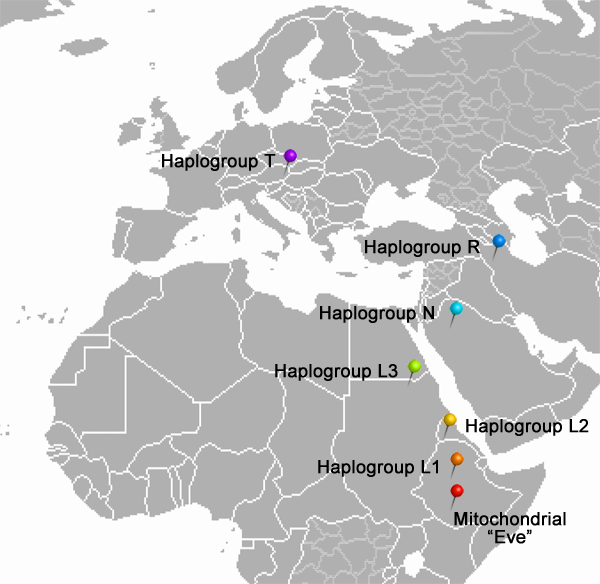Mitochondrial DNA • Haplogroup T2a1
Mitochondrial DNA (mtDNA) is passed down from a mother to all of her children. It stretches back to the Mitochondrial Eve, the name geneticists give to the matrilineal most recent common ancestor (MRCA) of all humans on the planet, i.e., the most-recent woman from whom everyone on the planet is descended. The analog in the purely male line would be Y-chromosomal Adam. However, while Y-chromosomes can only be tested in males, everyone has mitochondrial DNA from their mother.
It's important to note a couple of things about Mitochondrial Eve:
- It does not mean to the "first woman", nor even the first woman of our species. She is only the woman — whenever she existed — whose contemporaries have no living descendants.
- Eve is the matrilineal MRCA, not necessarily the absolute MRCA. Some mathematical studies have suggested that we might all share an ancestor as recently as 5,000 years ago.
- There are no unearthed remains corresponding to Mitochondrial Eve; she's an intellectual label for whatever woman in whatever era is our MRCA. In fact, Eve could shift backward in time if a new branch of the genetic tree is discovered, leading to a split prior to the current estimate of Eve (this happened recently to Y-chromosomal Adam due to testing some Sardinian men).
- Logically, Eve can also shift forward in time. Should all but one branch from Eve die out, the designation of Eve would move down to some female descendant in the surviving line.
Julie is part of the T2a1 hapologroup. Exact matches (within the limits of commerically-available DNA testing...which isn't exact) have been found in Poland, Ukraine and Russia. However, since mtDNA does not mix with the father's DNA, it passes along unchanged except for chance mutation. This means there is little precision in a match: a perfect one could be a sister or a someone who shares a great-great-great-great-great-grandmother.
The ancestors of this group left Africa in the ballpark of 50,000–70,000 years ago. They travelled up to the Middle East and, from there, into Central and Eastern Europe, where they've spread in all directions. The path can be traced by looking at mutations in the gene sequence, some place in the strand of DNA where one molecule is replace by another, or missing, or newly-inserted. For example, if we see a specific gene sequence in the vicinity of Saudi Arabia and 20,000 years later find evidence of that same sequence with one or more additional mutations in Syria, we can infer that, sometime during that period, some individuals migrated from Saudi Arabia to Syria, incurring a mutation along the way.The following map shows the approximate migration path of "direct ancestor" DNA groups, starting with the currently-presumed location of Mitochondrial Eve and moving north and then west to Europe. The pins on the map indicate the "stopping points" where a mutation caused the preceding group to split. A map showing all the major splits can be found here on FamilyTree.

Current estimates are that the mutations causing the splits occurred:
| Haplogroup | Approximate Separation |
| L1 from Eve | 120,000 years ago |
| L2 from L1 | 80,000 years ago |
| L3 from L2 | 70,000 years ago |
| N from L2 | 50,000 years ago |
| R from N | 50,000 years ago |
| T from R | 40,000 years ago |
According to Eupedia: "Haplogroup T2 peaks among the Udmurts (24%) and the Chechen-Ingush of Daghestan (12.5%). After that T2 is most frequently encountered in the Netherlands (12%), Sardinia (10%), Iceland (10%), Switzerland (9.5%), Hungary (8.5%) and Ukraine (8.5%), as well as among many ethnic groups around the Caucasus such as the Kumyks (10%), Azeri (9.5%) and Georgians (9%)." A heat map of the concentrations of T2 can be found on here on Eupedia.